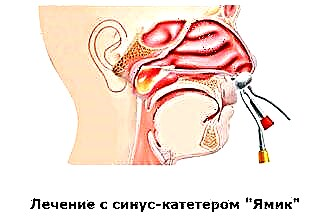 Laser removal of adenoids is a bloodless and low-traumatic method of excision of adenoid vegetations, which can be used to treat patients of almost any age group. Adenoids are an overgrown immune organ called the nasopharyngeal tonsil. It is located in the nasopharynx, therefore its hypertrophy, i.e. pathological enlargement, leads to blockage of the nasal passages and openings of the auditory tubes. If you do not carry out laser therapy or vaporization (vaporization of tissues with a laser) in a timely manner, this can lead to the development of catarrhal otitis media, sphenoiditis and other complications.
Laser removal of adenoids is a bloodless and low-traumatic method of excision of adenoid vegetations, which can be used to treat patients of almost any age group. Adenoids are an overgrown immune organ called the nasopharyngeal tonsil. It is located in the nasopharynx, therefore its hypertrophy, i.e. pathological enlargement, leads to blockage of the nasal passages and openings of the auditory tubes. If you do not carry out laser therapy or vaporization (vaporization of tissues with a laser) in a timely manner, this can lead to the development of catarrhal otitis media, sphenoiditis and other complications.
What is laser therapy?
Laser treatment of adenoids allows not only surgical operations, but also physiotherapy procedures. The therapeutic effect largely depends on the intensity of light exposure, the degree of polarization and the depth of penetration of the monochromatic beam into the amygdala tissue. The laser has antimicrobial, anti-edema, wound healing and disinfecting effect, due to which the following therapeutic effects are achieved:
- foci of inflammation are eliminated;
- microbes and viruses are destroyed;
- local immunity increases;
- facilitates nasal breathing;
- metabolic processes are normalized;
- lymphoid tissues are cleared of purulent plugs;
- improves blood circulation in hypertrophied tissues.
It should be understood that physiotherapy helps to reduce the size of the amygdala only by reducing swelling and inflammation in the tissues.
Many otolaryngologists note that laser treatment can be carried out even in cases where hypertrophic processes are complicated by inflammation. In other words, it is advisable to use laser therapy at the stage of exacerbation of adenoiditis.
Laser types
Laser therapy for adenoids is one of the most popular and safe methods of treating organ hypertrophy. During the procedure, special devices are used that emit electromagnetic vibrations of a certain wavelength and intensity. Depending on the technical characteristics and radiation parameters, laser equipment is divided into two types:
- low-frequency lasers - generators of ultraviolet, red and infrared radiation, which have a certain depth of penetration into soft tissues; are used mainly for physiotherapy procedures, and not for evaporation of soft tissues;
- high-frequency lasers - emitters of monochromatic beams of high-frequency light, which are used for resection (removal) of adenoid enlargements; the so-called laser "knife" vaporizes tissue and promotes coagulation (sealing) of blood vessels.
Can adenoid laser be used to treat small children? The modern method of therapy is widely used to treat adenoid vegetations in patients of almost any age. Laser radiation has an analgesic effect, so treatment procedures can be performed under local anesthesia.
Depending on the intensity and frequency of the light wave, laser therapy can be used both to treat and remove adenoid enlargements.
Physiotherapy
It is possible to cure grade 1 and 2 adenoids without surgery, provided that systemic drugs and physiotherapy procedures are used. Removal of tissues is carried out exclusively in cases where the hypertrophied tonsil interferes with normal nasal breathing or causes complications - otitis media, sinusitis, frequent relapses of ENT diseases. Two methods can be used to treat a non-communicable disease with a laser:
- intraoperative - a procedure in which laser radiation is used as an adjunct to classical adenotomy; after removal of the overgrown tissue with an annular scalpel (adenotome), the wound surfaces are treated with a laser, which "seals" the vessels, which prevents bleeding;
- non-invasive - treatment of the enlarged pharyngeal tonsil with a monochromatic stream of light radiation, which relieves puffiness, normalizes metabolic processes and stimulates tissue regeneration.
It is advisable to treat adenoids with a laser only at the initial stages of the development of pathology. If the overgrown glandular tissue overlaps the nasopharynx by more than 33-35%, the patient will be prescribed an operation, which can also be performed using a laser.
When is an adenotomy performed?
 In what cases is adenotomy performed and is surgical treatment effective? Adenotomy is performed only in the presence of serious indications and the practical absence of a positive effect from the use of drug treatment. In fact, laser reduction of adenoids is not a direct surgical procedure. During the procedure, the specialist does not make incisions, but only evaporates the adenoids using a concentrated light beam.
In what cases is adenotomy performed and is surgical treatment effective? Adenotomy is performed only in the presence of serious indications and the practical absence of a positive effect from the use of drug treatment. In fact, laser reduction of adenoids is not a direct surgical procedure. During the procedure, the specialist does not make incisions, but only evaporates the adenoids using a concentrated light beam.
It is not necessary to carry out operations in the treatment of adenoids in children under 3 years of age, since the removal of the pharyngeal tonsil can negatively affect the development of immunity.
It is recommended to perform resection of a hypertrophied organ only at stages 2 and 3 of the development of adenoids. Surgical intervention is also carried out in cases where the pathology is complicated by chronic inflammation of the nasopharynx, otitis media, sinusitis, paratonsillar abscess, etc.
Features of laser reduction
How is laser removal of adenoids performed? The method of treatment depends on the degree of proliferation of adenoid tissues, their structure and accompanying clinical manifestations. Today, there are several ways to perform adenotomy, namely:
- with a slight increase in the size of the nasopharyngeal tonsil, the so-called vaporization is carried out, during which hypertrophied tissues are literally evaporated using a carbon dioxide laser; during the procedure, the adenoids are not excised, but smoothed out, due to which the patency of the nasal canals is restored;
- in the case of a strong proliferation of lymphoid accumulations, laser coagulation is performed, in which the amygdala is treated with a narrowly directed radiation flux; due to the appearance of a burn and necrotization (death) of tissues, adenoids are destroyed over time and simply disappear;
- to reduce the size of a hypertrophied organ, interstitial coagulation is used, due to which the submucosa of the tonsils is evaporated, as a result of which its size is significantly reduced;
- laser therapy can be combined with classical adenotomy to seal (coagulate) the vessels and evaporate the remaining pathological tissues.
Completely remove adenoids in case of several laser therapy sessions. To prevent inflammation of the operated tissues, the patient is prescribed immunostimulating and anti-inflammatory drugs.
Rehabilitation
Not all patients know that the removal of a hypertrophied organ negatively affects local immunity. The pharyngeal tonsil protects the respiratory system from the penetration of viruses, microbes and allergens.Resection of the adenoids leads to a decrease in the resistance of the ENT organs to the negative effects of opportunistic microorganisms.
To prevent complications, after the end of the course of laser therapy, the patient is prescribed appropriate homeopathic and drug therapy. It is not recommended for 3 weeks after adenotomy:
- visit saunas and swimming pools;
- be in the sun;
- eat spicy and fatty foods;
- exercise;
- take hot baths;
- visit public places.
It is possible to speed up the process of restoring nasal breathing when carrying out breathing exercises and using vasoconstrictor nasal drops.
Contraindications
Like many other types of apparatus therapy, laser treatment of adenoids has some contraindications. Before the procedure, it is necessary to undergo a thorough examination by an otolaryngologist, which consists in conducting a posterior rhinoscopy, endoscopic examination and radiography of the paranasal sinuses.
It is not recommended to resort to laser reduction when:
- tuberculosis;
- iron deficiency anemia;
- blood diseases;
- cardiovascular insufficiency;
- malfunctions of the thymus gland;
- exacerbation of infectious diseases;
- malignant formations in the respiratory organs.
High precision, sterility and low trauma have made laser therapy one of the most demanded procedures in the field of otolaryngology.
With the help of a monochromatic beam of light, you can not only remove, but also simply reduce the size of the enlarged pharyngeal tonsil. This allows not only to preserve local immunity, but also to achieve a significant improvement in the patient's well-being. Unlike direct surgery, laser adenotomy shortens the rehabilitation period from 1 month to 2-3 weeks.



